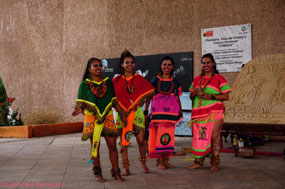Wed, Oct 4 – Puerto
Chiapas, Mexico is an important
commercial port in the state of Chiapas. The port was built in 1975, providing
a shipping terminal for the area's agricultural products, and to promote tourism
to the region. This area is known for its coffee
plantations, which the Germans established in the 1880s. During that period, many Japanese and Chinese
immigrants also made their way to the region to work on the new
railway lines and work in the fields and mines. Coffee cultivation and other
agricultural-related businesses are the mainstays of the area's economy.
The local residents can trace their history back over 3,700
years, to primitive societies whose ruins can still be seen at
Izapa. After Mexican independence from Spain in
1821, the Soconusco region became part of the United Provinces of Central
America, and in 1841, the area was taken over by Guatemala. It wasn't until 1881
that the region once again became part of Mexico.
Izapa is a very large Mayan site located on the Izapa River, near the base of the Tacaná
volcano.
The settlement at Izapa extended over 1.4 miles, making it the largest
site in Chiapas. It is thought that this site was started around 1500 BCE (before current era) and lasted until it was abandoned around 1200 CE (current era).
Our first stop on our tour was Tapachula, which is the largest city in the region, with a population of over 450, 000. We were shown the local city hall with its beautiful stained glass windows and their history which depicted in dioramas on the walls. It was quite hard to get any photos as this is a very active city hall. We then were given a walk around the square learning of the local history, which was hard to understand with all the cars and people running around - we got some of it, but not enough to discuss it correctly. We were then given a cultural dance and singing demonstration, which was quite entertaining - they put their heart into their dance and music.
Our next stop was to the University's Planatarium, which discusses the Mayan calendar. It was said that it was this calendar that believed the world would end in 2012 - obviously that didn't happen. We were given a dance demonstration of life in the Mayan culture and then we wandered around the planatarium. We then headed out to the Izapa Pyramids and walked all around them. It is said that this culture was a very agricultural society and the cacao trees grow right up to the boundaries. It was a very interesting tour and I only wish I could retained all that was being told to us.
One of the things we are missing on these trips is that the sites do not have a book shop where we can get a book or two on the history of the site. It is so helpful when you are being given a boat load of information and then attempt to recall what you were told many hours later.
It was a wonderful visit and we are so glad we got to do it. We headed back to the ship, had an early dinner up on the Lido deck and into bed. I am not doing well.

 Puerto Chiapas, Chiapas, Mexico
Puerto Chiapas, Chiapas, Mexico













2025-05-22